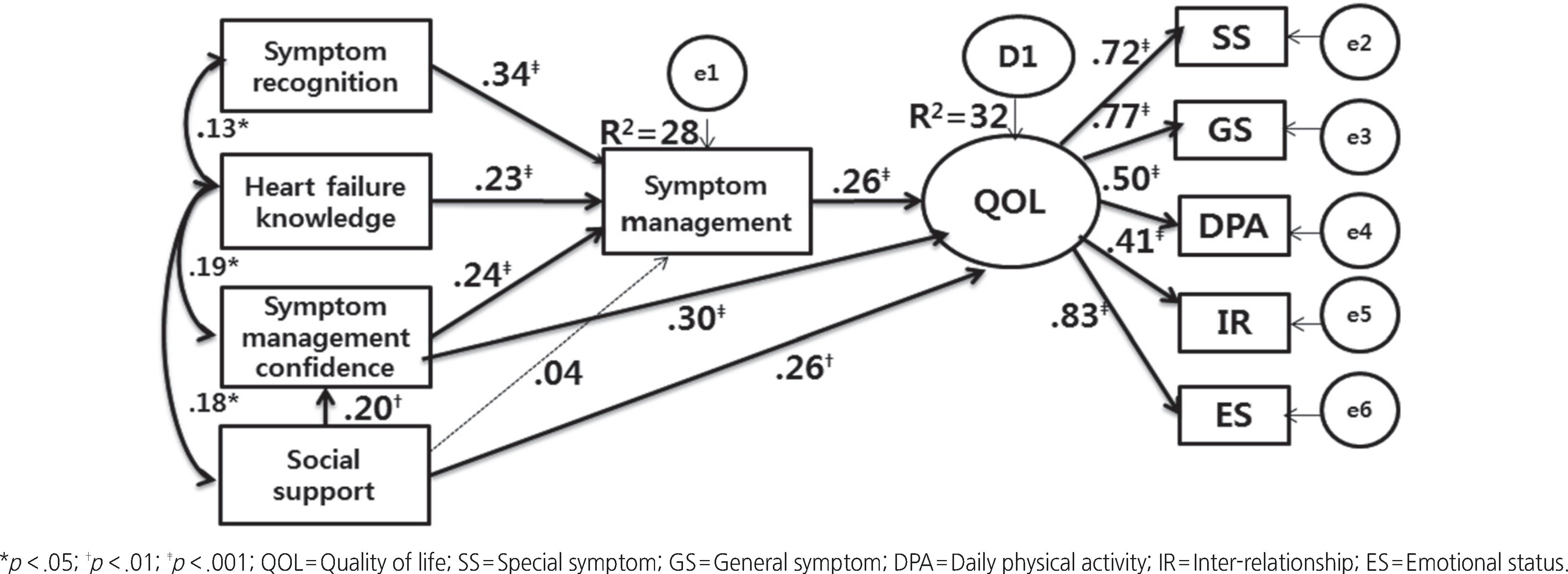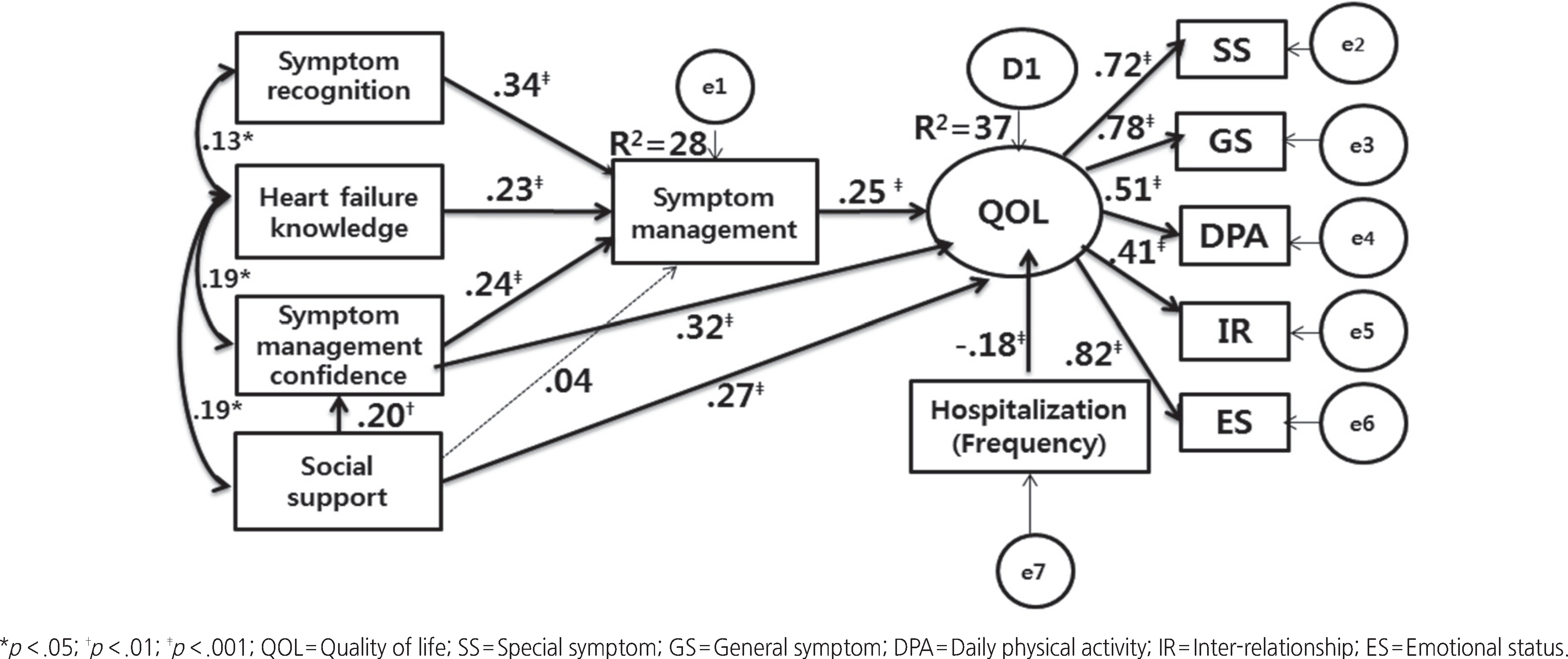J Korean Acad Nurs.
2015 Dec;45(6):846-856. 10.4040/jkan.2015.45.6.846.
Symptom Management to Predict Quality of Life in Patients with Heart Failure: A Structural Equation Modeling Approach
- Affiliations
-
- 1The Catholic University Daejeon St. Mary's Hospital, Daejeon, Korea.
- 2College of Nursing, Chungnam National University, Daejeon, Korea. songry@cnu.ac.kr
- KMID: 2363108
- DOI: http://doi.org/10.4040/jkan.2015.45.6.846
Abstract
- PURPOSE
The focus of this study was on symptom management to predict quality of life among individuals with heart failure. The theoretical model was constructed based on situation-specific theory of heart failure self-care and literature review.
METHODS
For participants, 241 outpatients at a university hospital were invited to the study from May 19 to July 30, 2014. Data were collected with structured questionnaires and analyzed using SPSSWIN and AMOS 20.0.
RESULTS
The goodness of fit index for the hypothetical model was .93, incremental fit index, .90, and comparative fit index, .90. As the outcomes satisfied the recommended level, the hypothetical model appeared to fit the data. Seven of the eight hypotheses selected for the hypothetical model were statistically significant. The predictors of symptom management, symptom management confidence and social support together explained 32% of the variance in quality of life. The 28% of variance in symptom management was explained by symptom recognition, heart failure knowledge and symptom management confidence. The 4% of variance in symptom management confidence was explained by social support.
CONCLUSION
The hypothetical model of this study was confirmed to be adequate in explaining and predicting quality of life among patients with heart failure through symptom management. Effective strategies to improve quality of life among patients with heart failure should focus on symptom management. Symptom management can be enhanced by providing educational programs, encouraging social support and confidence, consequently improving quality of life among this population.
Keyword
MeSH Terms
Figure
Reference
-
References
1. The Korean Society of Circulation, Heart Failure Study Group. The manual of heart failure. Seoul: MMK Communications;2007.2. Riegel B, Lee CS, Dickson VV, Carlson B. An update on the self- care of heart failure index. The Journal of Cardiovascular Nursing. 2009; 24(6):485–497. http://dx.doi.org/10.1097/JCN.0b013e3181b4baa0.3. Son YJ, Kim SH, Kim GY. Factors influencing adherence to self care in patients with chronic heart failure. Korean Journal of Adult Nursing. 2011; 23(3):244–254.4. Statistics Korea. 2013 annual report on the cause of death statis- tics. Daejeon: Author;2014.5. Lee ES, Shin ES, Hwang SY, Chae MJ, Jeong MH. Effects of tai- lored supportive education on physical, emotional status and quality of life in patients with congestive heart failure. Korean Journal of Adult Nursing. 2013; 25(1):62–73. http://dx.doi.org/10.7475/kjan.2013.25.1.62.6. Ahmed A. Chronic heart failure in older adults. The Medical Clin- ics of North America. 2011; 95(3):439–461. http://dx.doi.org/10.1016/j.mcna.2011.02.001.
Article7. Blinderman CD, Homel P, Billings JA, Portenoy RK, Tennstedt SL. Symptom distress and quality of life in patients with advanced congestive heart failure. Journal of Pain and Symptom Manage- ment. 2008; 35(6):594–603. http://dx.doi.org/10.1016/j.jpainsymman.2007.06.007.
Article8. Zambroski CH, Moser DK, Bhat G, Ziegler C. Impact of symptom prevalence and symptom burden on quality of life in patients with heart failure. European Journal of Cardiovascular Nursing. 2005; 4(3):198–206. http://dx.doi.org/10.1016/j.ejcnurse.2005.03.010.
Article10. Jurgens CY, Lee CS, Reitano JM, Riegel B. Heart failure symptom monitoring and response training. Heart and Lung. 2013; 42(4):273–280. http://dx.doi.org/10.1016/j.hrtlng.2013.03.005.
Article11. Dodd M, Janson S, Facione N, Faucett J, Froelicher ES, Hum- phreys J, et al. Advancing the science of symptom management. Journal of Advanced Nursing. 2001; 33(5):668–676. http://dx.doi.org/10.1046/j.1365-2648.2001.01697.x.
Article12. Riegel B, Dickson VV. A situation-specific theory of heart failure self-care. The Journal of Cardiovascular Nursing. 2008; 23(3):190–196. http://dx.doi.org/10.1097/01.jcn.0000305091.35259.85.
Article13. Gallagher R, Luttik ML, Jaarsma T. Social support and self-care in heart failure. The Journal of Cardiovascular Nursing. 2011; 26(6):439–445. http://dx.doi.org/10.1097/JCN.0b013e31820984e1.
Article14. Graven LJ, Grant JS. Social support and self-care behaviors in in- dividuals with heart failure: An integrative review. International Journal of Nursing Studies. 2014; 51(2):320–333. http://dx.doi.org/10.1016/j.ijnurstu.2013.06.013.15. Lee SH, Ahn SH. Self care compliance, family support, and de- pression in patients with congestive heart failure. Journal of Korean Academy of Fundamentals of Nursing. 2005; 12(2):186–194.16. Lainscak M, Keber I. Validation of self assessment patient knowl- edge questionnaire for heart failure patients. European Journal of Cardiovascular Nursing. 2005; 4(4):269–272.17. Kim YS. A path analysis model of health-related quality of life in patients with heart failure. Journal of Korean Academy of Adult Nursing. 2007; 19(4):547–555.18. Krethong P, Jirapaet V, Jitpanya C, Sloan R. A causal model of health-related quality of life in Thai patients with heart-failure. Journal of Nursing Scholarship. 2008; 40(3):254–260. http://dx.doi.org/10.1111/j.1547-5069.2008.00235.x.
Article19. Yu JP. The concept and understanding of structural equation mod- eling. Seoul: Hannare Publishing Co.;2012.20. Cobb S. Presidential address-1976. Social support as a moderator of life stress. Psychosomatic Medicine. 1976; 38(5):300–314.21. Kang HS. An experimental study of the effects of reinforcement education for rehabilitation on hemiplegia patients’ self-care activ- ities [dissertation]. Seoul: Yonsei University;1984.22. Lee EH, Tahk SJ, Shin JH, Lee YW, Song R. Development and a psychometric evaluation of cardiovascular disease-specific quality of life scale for Koreans. Journal of Korean Academy of Nursing. 2007; 37(3):313–323.
Article23. Charlson ME, Pompei P, Ales KL, MacKenzie CR. A new method of classifying prognostic comorbidity in longitudinal studies: Devel- opment and validation. Journal of Chronic Diseases. 1987; 40(5):373–383. http://dx.doi.org/10.1016/0021-9681(87)90171-8.24. Vellone E, Riegel B, D’Agostino F, Fida R, Rocco G, Cocchieri A, et al. Structural equation model testing the situation-specific the- ory of heart failure self-care. Journal of Advanced Nursing. 2013; 69(11):2481–2492. http://dx.doi.org/10.1111/jan.12126.25. Riegel B, Dickson VV, Cameron J, Johnson JC, Bunker S, Page K, et al. Symptom recognition in elders with heart failure. Journal of Nursing Scholarship. 2010; 42(1):92–100. http://dx.doi.org/10.1111/j.1547-5069.2010.01333.x.
Article26. Mata J, Frank R, Gigerenzer G. Symptom recognition of heart at- tack and stroke in nine European countries: A representative sur- vey. Health Expectations. 2014; 17(3):376–387. http://dx.doi.org/10.1111/j.1369-7625.2011.00764.x.27. Cen CW, Haymore LB, Dolan-Soto D, Lin FC, Pignone M, Dewalt DA, et al. Self-care confidence mediates the relationship between perceived social support and self-care maintenance in adults with heart failure. Journal of Cardiac Failure. 2013; 19(3):202–210. http://dx.doi.org/10.1016/j.cardfail.2013.01.009.
Article28. Kim HN. Symptom experience, symptom management strategies and health-related quality of life in patients with pancreatic cancer [master’s thesis]. Seoul: Yonsei University;2013.29. Kato N, Kinugawa K, Ito N, Yao A, Watanabe M, Imai Y, et al. Adherence to self-care behavior and factors related to this behav- ior among patients with heart failure in Japan. Heart and Lung. 2009; 38(5):398–409. http://dx.doi.org/10.1016/j.hrtlng.2008.11.002.30. Song EK, Kim CJ, Yoo IY, Kim GY, Kim JH, Ha JW. Factors in-fluencing functional status in patients with heart failure. Journal of Korean Academy of Nursing. 2006; 36(5):853–862.
Article
- Full Text Links
- Actions
-
Cited
- CITED
-
- Close
- Share
- Similar articles
-
- Structural Equation Model of Health-Related Quality of Life in School Age Children with Asthma
- Control Effect of Illness Perception on Depression and Quality of Life in Patients with Hemodialysis: Using Structural Equation Modeling
- Structural equation modeling for association between patient satisfaction and quality of life after implant surgery
- The Mediator Role of Meaning in Life in the Life Quality of Patients With Chronic Heart Failure
- Structural Equation Modeling on Life-world Integration in People with Severe Burns




